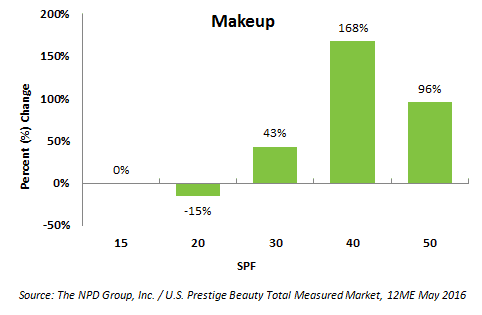
When it comes to sun protection, SPF 30+ is outshining lower SPFs, NPD Group reports. Across skincare and makeup, SPF 15, the largest segment based on dollars, saw sales decline as consumers sought higher levels of sun protection.
The American Academy of Dermatology recommends sunscreen that offers not only broad-spectrum protection and water resistance, but a Sun Protector Factor of 30 or higher. According to global information company The NPD Group, sales of prestige skincare and makeup products with any SPF reached $1.4 billion in the 12 months ending May 2016, growing by 7 percent over the last two years. Coinciding with the AAD’s guidelines, such products with an SPF of 30 or higher are seeing the greatest growth and outpacing the total SPF market by at least twofold.
Dermatologists can encourage patients to increase sunscreen usage and up the SPF to 30 in emailed ads or newsletter advertising because 32% of Dermatologist Patients took action based on their inboxes, according to AudienceSCAN data.
“Sun care looks to be the next beauty growth area to emerge, as consumers move from a singular focus on correction to a broader focus on care,” said Karen Grant, global beauty industry analyst, The NPD Group.
Across skincare and makeup SPF 15, the largest segment in terms of dollar sales, experienced a decline in the 12 months ending May 2016, as share shifted to the higher levels of sun protection. Within skincare, sales of SPF 40–50 grew by over $36 million while makeup sales in this range more than doubled, to $14 million. This trend toward higher SPFs exists not only within the sunscreen and broader skincare markets, but is becoming increasingly evident in products ranging from facial moisturizers to foundation. At the same time, self-tanners returned to growth after a decline, perhaps indicative of consumer concern with the sun and opting for a UV-free alternative for a summer glow. Self-tanners experienced a 7 percent increase in sales from June 2015-May 2016 after a decline the year prior.
Also, dermatologists should feature any specific products they endorse and carry in their own clinics in advertising. Patients are open to influence in this hot category. AudienceSCAN reports 23% of Dermatologist Patients already plan to pay for facial or other day spa services. Adding recommended skincare products to this purchase should be a priority.
“From what they eat to what they put on their bodies, consumers are becoming more focused and well-versed in health and wellness. Consumers today are more proactive and less reactive when it comes to managing their well-being. This attitude also translates to the beauty consumer, whose emphasis today weighs less on fixing an issue, and more on preventing one from happening in the first place,” said Grant. “For more than a decade, all the news in skincare was about serums and technology, but today the focus has shifted to cleaner, simpler, and lighter products. The growth in products with higher SPF ties into today’s mindset and is connected to other emerging care formats including oil, water, milk, and clay.”
AudienceSCAN data is available as part of a subscription to AdMall for Agencies, or with the SalesFuel API. Media companies can access AudienceSCAN data through the AudienceSCAN Reports in AdMall.
